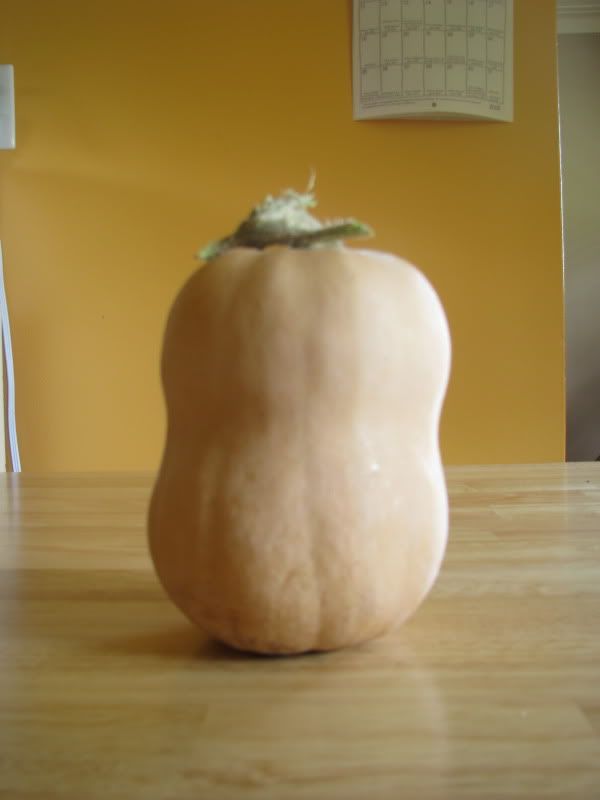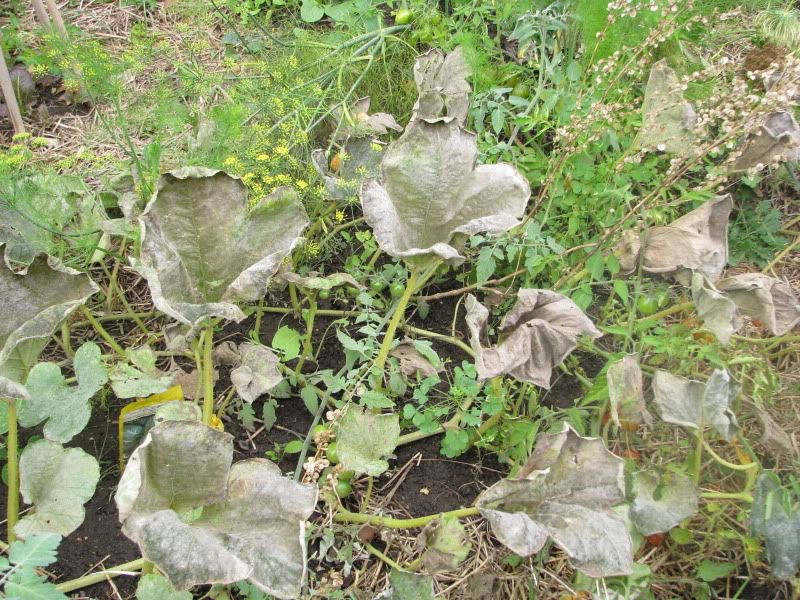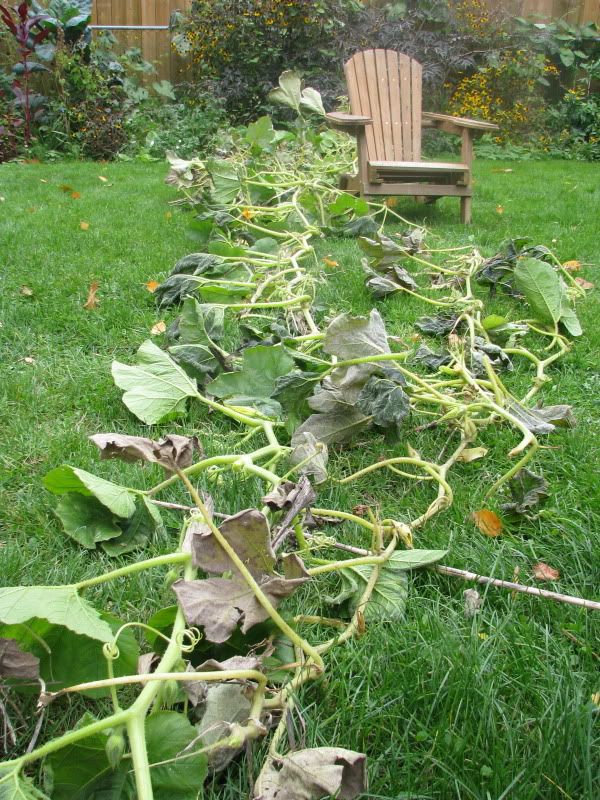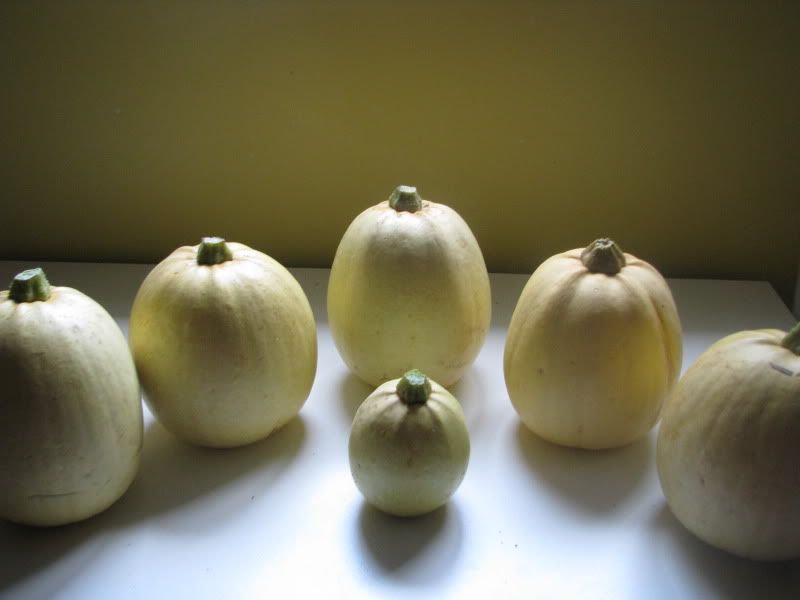Here is a lovely little butternut and...

... what it became, a couple lovely little pumpkin pies for Thanksgiving.

Of course the season here has come to an end and the leaves of the pumpkin have been wilted by powdery mildew:

The White Death: Powdery Mildew often starts around mid summer here. It doesn't usually kill the plant before...
and touched by frost:

The Black Death: Frost damage will turn the leaves brittle and darkened, sometimes black. Say so long to your squash plant. Though I have seen light frost singe upper leaves while leaving immature lower leaves untouched. It's possible there might be some regeneration but I usually yank them right afterward.
but I got a descent and delcious harvest despite the slow start to this year.
The Long Tutorial on Squash Growing - go ahead read it, I dare you.
Starting from Seed
In Ottawa, you have two choices, start indoors or out. If you start indoors, they only need a short leap on the season of 3-4 weeks. Make sure they are started in something which you won't need to overly disturb the roots - think soil block, peat pot or newspaper cone. This is especially useful if you are trying to grow something with a slightly too long growing season or if your growing season is unusually short. It might also work as insurance against the unpredictablility of last frost.
You can also wintersow your squash by placing them in a mini greenhouse container outside and allow them to sprout when the microclimate suits them, which I find is usually around 2-4 weeks early. Some people provide extra early warming of the soil by planting in black tires placed on your mound directly on the ground. You can stretch plastic or floating row cover overtop to increase the warmth. I think this works better to speed germination but should be removed afterwards to prevent the solar oven effect.
Or you can direct seed. Since squash plants are hungry plants, dig in some manure, compost or other organic matter. Many people mound up the ground which can give extra growing room and heat but this is not necessary. Others plant pumpkins with beans and corn in the classic Three Sisters arrangement.
Plant no more than three seeds and stand back. If you have problems with cucumber beetle eating your seedlings, give them some protection such as a large bottomless margarine container twisted into the ground (will also protect against cut worms) with nylon stretched across the top. This only gives them a head start as the plant often outgrow this confined protective area. Feel free to create larger versions. Anyhow, up pops the plants and on they grow.
Cut off the head of the weakest seedling. Go on, do it. Don't let your kids watch, they might not let you. If you are me, then let the other two grow to hedge your bets or wait a few weeks and then mow down one more, leaving only one plant per hill.
Growing On

One squash vine freshly pulled from the garden displaying both forms of Death (see pics above). Notice the lawn chair for scale... okay I admit it is a child's size lawn chair but still.
If you are growing a bush-type squash, then they'll become rather large plants, needing about four square feeet to accomodate them but if you have the more exciting vining variety then it will need room! How much? Think 10-30 foot vines and you'll have an idea. There are a number of ways to handle this. Firstly, you can let them ramble amoung your other vegetables. Their big leaves will shade out some planting spots but also some weeds. You could also plant them at the edge of the garden bed letting them wander around the yard. This is a sneaky way of extending your veggie garden (ha hahahahahah) and it cuts down on the amount of lawn you are able to mow. You can also move the spreading vines so that they border the garden or stay out of the way though they will forever seek the best growing conditions like light, heat, nutrients etc... You can also let them ramble up trellises, existing trees and more. Trellising is good for small fruited / summer eating varieties but for larger fruited ones, you'll have to support the fruit. Nylon or other strong netting can be used to build little hammocks. An advantage to ground growing is that the plant tends to root along the vine giving it more access to water and nutrients. If fruit is allowed to mature along the ground, you may get slug scarring but unless it is heavy, I just find it adds to their character.
Usually male flowers appear first followed by females with minature fruit on the bottoms. You can eat squash flowers which are stuffed, battered, fried and more but leave some for pollination. If you are eating the immature fruit such as in zucchini or trombocino then keep them picked young so that the plant will keep producing more. If they are winter squash such as butternut or hubbards, let them ripen on the vine until the rind is hard and mature coloured (colour depends on variety). Cut cleanly off the vine with a sharp knife before the first frost, including as much stem as possible. Never pick up by the 'handle' since broken handles mean fruit spoiling more quickly.
Storage

Descent harvest minus one that I ate before this picture from a single squash plant (same as pictured vine above.) You want to know the variety? Um... a nice Quebecoise seed seller gave me it... um... don't recall. It's somewhere in my seed tower...
If you are me, then dust off dirt and stick on a cool, airy shelf in the house until you want to eat them. If you are a less lazy gardener, you may want to wash them in a weak bleach solution to limit the amount of interloping rot causers, let them thoroughly dry and then store in a cool, well ventilated spot. Remember to check often for rotting and cull the bad ones. I guess it goes without saying that you should eat those with a shorter shelf life first as not all varieties have the same storage capacity.
Seed Saving
Squash plants are outbreeding and insect pollinated which means that your courgette (nod to you Europeans out there) may cross with your pumpkin to produce pumpettes and you need a lot of plants to maintain the genetic wealth of the variety and keep it strong.
Not all squash plants will cross. There are four main species that gardeners grow (this is not a complete list, no way, no how. Seed to Seed by Ashcroft has a good list). These are:
Cucurbit moschata: Butternut, Cheese
Cucurbit pepo: Many pumpkin and zucchini are in this category
Cucurbit maxima: Hubbard, Banana
Cucurbit mixta: various Cushaws, silver seeded gourds
So if two squash in your garden share the same surname (species name) then they can cross. Your real problem is getting enough plants to save good seed. Seed to Seed says 24 plants - yes I mean 20+4 not 2 to 4... 'is the recommended population size at goverement facilities.' If you are only saving for yourself or informed friends, then you can try saving from as many plants as would be sane for your garden. Store the seed well so you can use it for a couple years as long as the plants perform as you would like. Over time, if you continue to save from only 2 or 3 plants, you will get a weak, narrow genetic line so you'll probably want to buy or trade for new seed.*
Saving the seed is easy. Scoop out, separate from guck, dry really, really well and save in a clearly labelled air tight container. Keep out of light, moisture and heat.
***
*If you haven't read anything about seed saving and population size before and are now suddenly freaked out, FEAR NOT as not all plants are as space hungry as squash. Many are self pollinating and could be saved from just a few plants though more is always better.
I Wet My Plants and her series on wintersowing plants which include squash

3 comments:
Thanks for this great post! It's so informative. And of course, I just happen to be saving some squash seeds nowadays, so it was interesting to learn about the long term diversity issue in regards to using 2 vs 24 plants. Also very interesting to learn that some of them can cross, I never knew that! Most of all, I find your information very valuable because I'm in Ottawa too. Thanks for sharing :)
I did read the whole thing and my 14 year old even laughed out loud at the idea for annexing the yard via squash. Of course, she's observed this first hand.
Don't forget squash ravioli. Yum, yum yum. . .
Meagan, Yeah it took me ages to find exact information about population numbers for various plants and even then it doesn't seem like an exact science. There are a few of us in Ottawa. Do you ever go on plantcycle? I think maybe we should have a spring seed fling or something one of these days.
Stefaneener: I made a 14 year old laugh. Shock. Mmm... ravioli...
Post a Comment